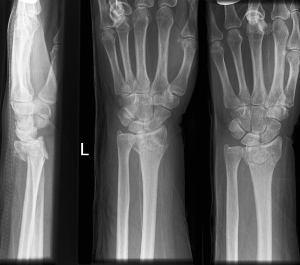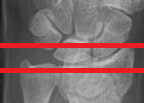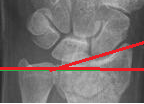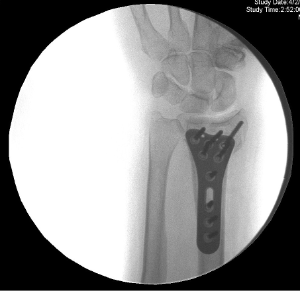8 Distal Radius (Colles) Fractures
Fractures of the distal radius are common. Fractures of the distal radius are often sustained after a fall on the out-stretched hand and are often associated with osteoporosis. Distral radius fractures are frequently accompanied by fractures of the ulnar styloid (with possible injury to the cartilage attached to it) or with injuries to the wrist ligaments. Associated injuries to the nearby cartilage and ligaments are also frequently seen. The eponym “Colles’ fracture” has been used to describe all distal radius fractures, though that name refers specifically to fractures that are angulated dorsally.

Structure and function
The distal radius forms the proximal side of the wrist joint. There, the radius articulates with the proximal row of carpal bones (allowing flexion and extension); it also articulates with the distal ulna (creating a joint for pronation and supination).
The distal ulna attaches to a meniscus-like structure, the triangular fibrocartilage discus, which can be torn with wrist fractures.
On the lateral side of the radius is a styloid process, onto which the brachioradialis inserts and from which the radial collateral ligament of the wrist originates.
At the distal metaphysis of the radius, the cortex of the bone is thinner than the bone proximal and distal, and the relative amount of cancellous bone increases. The distal metaphysis of the radius is therefore a relative weak point. This makes fractures more likely, especially in patients with decreased bone mineral density.
Patient presentation
A patient with a fracture of the distal metaphysis of the radius typically describes falling on an outstretched hand or sustaining a direct blow to the wrist. He or she will complain of wrist pain and swelling.
The deformity that results from the Colles’ fracture is described as a “dinner fork” deformity because of depression at the fracture site, dorsal angulation, and dorsal displacement of the distal radius.
History-taking should focus on the mechanism of injury and amount of energy involved. This information can alert the clinician to the presence of associated injuries (in the case of high energy mechanisms, such as motor vehicle accidents) or the presence of osteoporosis (in the case of low energy mechanisms, such as a fall from a standing height).
Physical examination (and imaging) should assess for the following:
- An open wound
- Acute carpal tunnel syndrome (characterized by weakness or loss of thumb or index finger flexion, tingling [“paresethesia”] or alterations of sensation in the median distribution)
- Vascular injury (which is rare)
- Injury to the elbow
- Injury to the ulnar side of the wrist
- Injury to the carpal bones
(The latter three should remind you of the rule “Always assess the joints above and below the known injury.”)
Objective evidence
PA, lateral, and oblique radiographs of the distal radius that include the carpal bones should be obtained. All three radiographs should be examined for a loss of normal anatomy, disruption of the articular surface, involvement of the distal radio-ulnar and radiocarpal joints, and evidence of comminution.
PA radiographs allow for evaluation of the integrity of the distal radio-ulnar joint, the radiocarpal joint, the proximal carpal row, and the radial and ulnar styloid processes.
Three measurements on PA films allow for characterization of the injury: radial height, radial inclination, and palmar (volar) tilt
Radial height is the distance between two parallel lines perpendicular to the long axis of the radius. The first line is drawn tangential to the distal tip of the radial styloid and the second tangential to the distal ulna, (Figure 2). Normal radial height is approximately 12 mm and is decreased in distal radius fractures.

Radial inclination is the angle between one line drawn perpendicular to the long axis of the radius and a second drawn from the distal tip of the radial styloid to the ulna, (Figure 3). Radial inclination ranges from approximately 20 to 25 degrees and is decreased in distal radius fractures.

Palmar tilt is measured from lateral radiographs. Palmar tilt is the angle formed between a first line drawn perpendicular to the long axis of the radius and a second line connecting the palmar and dorsal edges of radius, (Figure 4). In the fracture shown above, the tilt is actually in the dorsal direction.

Epidemiology
Distal radius fractures are one of the most common fractures of the upper extremity, and therefore, represent a large proportion of fractures seen by Primary Care physicians and Emergency Medicine physicians. Distal radius fractures have a bimodal distribution: one peak in the 18-25 year old age group and another in the 65 and older age group. In younger people, high energy injuries are more common, such as those from motor vehicle collisions, motorcycle collisions, sports, or falls from an extended height. In older people, distal radius fractures are typically lower energy injuries, i.e. from a simple fall on outstretched hand from standing height or lower. These are categorized as “fragility fractures” meaning that weakness of the bone contributes to the cause.
Differential diagnosis
Distal radius fractures are detected on imaging. The classification of these fractures should consider whether they are intra- vs extra-articular; displaced vs non-displaced; comminuted or not; open or closed (i.e. skin broken or not); and whether there are associated injuries.
Concomitant injuries must be excluded, including shoulder, elbow and neurovascular injuries. Scaphoid fractures, scapholunate ligament injury, and fractures of the ulnar styloid process are injuries associated with distal radius fractures, given their anatomic proximity to the distal radius. Tenderness in the anatomical snuffbox is suggestive of scaphoid fracture.
Red flags
An isolated and non-complicated low energy fracture is itself a red flag: it may reflect previously undetected osteoporosis or other metabolic bone disease. Treatment of the fracture without consideration of the source of fragility is, to say the least, a missed opportunity.
Pain proximal to the wrist suggests the presence of an injury proximal to the wrist. Regardless, radiographs must include the elbow joint, even without proximal pain.
Acute carpal tunnel syndrome may develop following a fracture of the distal radius. Clinical findings specific to an acute carpal tunnel syndrome are weakness or loss of thumb or index finger flexion. A sensory finding in median nerve distribution is not specific to acute carpal tunnel syndrome as it may be caused by a median nerve contusion at the time of injury or reduction. Discerning between the two is a difficult one (theoretically, a contusion should have immediate sensory findings which do not get worse over time, whereas acute carpal tunnel syndrome is more likely to have progressive weakness).
Treatment options and outcomes
The goal of treatment is to create the biological and mechanical environment that promotes bone healing and restores maximal function. The goal of completely restoring the wrist to its pre-injury state is often beyond reach.
Non-Operative
Many fractures of the distal radius can be treated without surgery. Nonsurgical treatment is usually indicated for non-displaced or minimally displace fractures.
Acutely, non-displaced or minimally displaced fractures can be treated with a sugar tong splint. Upon examination 5 to 7 days after initial treatment, the splint can be exchanged for a short arm cast. Immobilization for 6-8 weeks usually suffices; though radiographic healing and clinical exam dictate the length of treatment. A new cast may be required mid-way through treatment if atrophy of the forearm renders the initial cast too loose.
Displaced extra-articular fractures of the distal radius should be reduced (that is, manually placed in a position of normal anatomy). If proper alignment can be attained and held, these originally-displaced fractures can usually be treated as if they were non-displaced from the start, though patients may need to remain in the splint for a longer duration as the swelling subsides.
Operative
Surgical treatment of fractures of the distal radius is indicated when these fractures are largely displaced, reduced but unstable, irreducible, comminuted, or involving the distal radio-ulnar joint or radiocarpal joint.
Options for surgical treatment of distal radius fractures include percutaneous pinning, external fixation, or plating (Figure 5). The choice of surgical treatment varies considerably among patients, surgeons, institutions, and nations; no single surgical method has been uniformly proven to be superior to others.
If a displaced fracture of the distal radius is left untreated, the resulting deformity will leave the person with dorsal angulation, limited supination, and a weak grip. Malunion of the fracture site is associated with wrist pain and rupture of the extensor pollicis longus tendon.
Rupture of the extensor pollicis longus tendon can result from the tendon repeatedly moving across the fracture site (or surgical hardware).
Even well-treated injuries may resolve with objective deficits including loss of motion and radiographic evidence of arthrosis; these may be a consequence of the original injury and damage to the articular surface.
Elderly patients with low demands can typically return to baseline activities of daily living even with less than full motion or arthrosis.

Risk factors and prevention
In younger patients with high energy mechanisms of injury, distal radius fractures typically occur from motor vehicle accidents or sports trauma. Wrist guards and elbow pads can prevent upper extremity injuries in many sports, including inline skating and snowboarding.
Decreased bone mineral density (typically from osteoporosis) is a risk factor for distal radius fractures. Therefore, prevention of distal radius fractures in older people should focus on prevention of osteoporosis and risk factor reduction. Clinicians should encourage adequate calcium and vitamin D intake, initiation of weight-bearing exercise, cessation of smoking, and moderation of alcohol intake.
Evaluation for osteoporosis is part of the treatment in an older patient with a distal radius fracture and low energy mechanism of injury. The following lab tests should be obtained to evaluate for secondary causes of osteoporosis: complete blood count, complete metabolic panel (including calcium and phosphorus, parathyroid hormone levels, and testosterone for males), thyroid stimulating hormone level, 25-hydroxyvitamin D level, and alkaline phosphatase. Serum calcium, phosphate, and alkaline phosphatase are normal in a patient with osteoporosis, but alkaline phosphatase may be elevated for months after a fracture.
Additionally, a dual energy x-ray absorptiometry (DEXA) scan of the vertebral bodies and femur can be ordered to evaluate the patient’s bone mineral density and screen for osteoporosis. Initiation of treatment may prevent a subsequent fragility fracture.
Miscellany
Eponyms about fracture of the distal radius.
- A Colles’ fracture, though at times used imprecisely to refer to all distal radius fractures, is the term for a transverse, dorsally displaced and angulated distal radius fracture about one inch proximal to the wrist. It is named for Abraham Colles, an Irish surgeon.
- A Smith’s fracture is a fracture of the distal radius with volar (palmar) displacement of the hand and wrist distal to the fracture. Based on this configuration, it can be thought of as a “reverse Colles’ fracture.” It is named after Robert William Smith, who followed Abraham Colles’ as professor of surgery at Trinity College in Dublin.
- A Barton’s fracture is an intra-articular fracture of the distal radius with dislocation of the radiocarpal joint, either in the volar or dorsal direction. It was described by John Rhea Barton, a surgeon at Pennsylvania Hospital in Philadelphia.
- The Chauffeur’s fracture is a fracture of the radial styloid process caused by a blow to the hand which compresses the carpus into the styloid process. This is a rare eponym that is not capitalized, as it refers to an occupation, not a person: years ago, when cars were started by a crank, back-firing could cause the starter crank to hit a chauffeur’s palm and in turn break the styloid
Key terms
distal radius fracture, Colles’ fracture, radial styloid, osteoporosis, carpal tunnel syndrome, fragility fracture, ulnar styloid.
Skills
Assess radiographs and describe the pattern of injury. Recognize fractures associated with osteoporosis and initiate a workup for it. Be able to counsel a patient on lifestyle modifications that prevent osteoporosis. Be able to apply a sugar tong splint or short arm cast to patient with a fracture of the distal radius.
